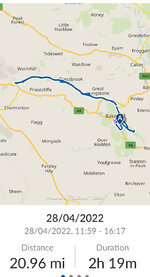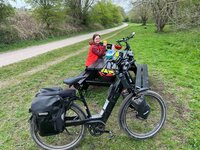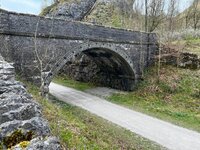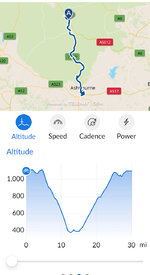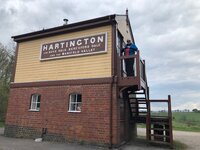Part Three: The Peaks
Our second Premier Inn hotel was to the west of Chesterfield, which is to the bottom right of the Peak District National Park.
The first ride was the Carsington Water. This is a Severn Trent Water reservoir, which was built in 1989 and opened in 1992.
Our first lunch stop.
Our second lunch stop.
A very windy day today. So much so that when we were riding on the dam wall, Mrs DG had to get off and push the bike as she was being blown over.
The second ride was on the Tissington Trail. This is an old railway line which opened in 1899 but closed in 1967. This ran from Parsley Hey to Ashbourne and was operated by the London and North Western Railway Company. It was formally used to transport milk to London and then sending limestone to industrial areas.
Our first lunch break.
Our second lunch break.
Not much infrastructure of the old line remains, but an old signal box and some elevation markers.
Mrs DG got a puncture in the rear tyre just after we started. Fortunately, the slime did its job and it didn’t fully deflate, stopping at 20psi. Checked the tyre and found a hole with some evidence of where the slime had come out. Nothing appeared to be stuck in it, so may have been a sharp stone. One CO2 capsule later and it was back up to 40psi.
The third ride was around Howden and Derwent reservoirs. This was built in 1916 and again run by Severn Trent Water.
Pleased to report that no further issues with Mrs DGs rear tyre as if stayed up overnight.
Our first lunch stop today.
We had a pair of Mallard ducks join us today and I think that they had more of our lunch then we did.
There was a memorial to the Dambusters Squadron 617 as they trained here in 1943.
Our second lunch stop.
The fourth ride was the High Peak Trail. This runs from Parsley Hay to High Peak Junction. This again was an old railway line that opened in 1831 was finally closed down in 1967. It was called the Cromford and High Peak Railway and carried minerals and goods.
In it’s time it had the steepest gradient ever on a railway line. There were three, 1 in 8 inclines, each with a flat section in between. And each had a stationary engine to winch the wagons up each gradient. On the flat sections, the wagons were pulled by horses.
Our first lunch stop.
Our second lunch stop.
Nice to see some of the railway infrastructure still in place.
The three inclines coming up were particularly steep and hard going as can be seen on this graph.
At one time the engine house for the bottom incline house the largest steam beam engine in the country.
We saw this memorial for the Headstones for the Commonwealth War Graves Commission.
Part Three to be continued...
